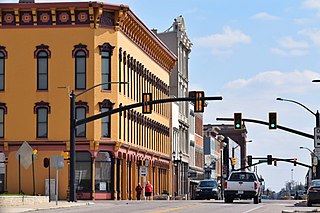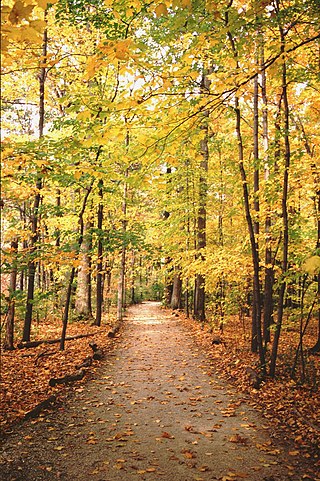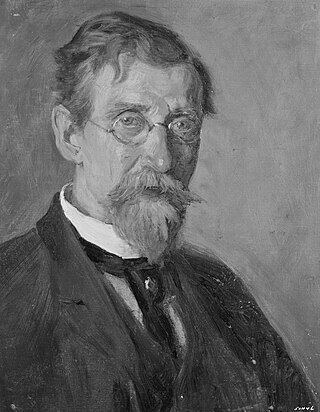
Muncie is an incorporated city and the seat of Delaware County, Indiana, United States. Previously known as Buckongahelas Town, named after the prominent Delaware Chief, it is located in East Central Indiana, about 50 miles (80 km) northeast of Indianapolis. At the 2020 United States Census, the city's population was 65,195, down from 70,085 in the 2010 Census. It is the principal city of the Muncie Metropolitan Statistical Area, which encompasses all of Delaware County. The city is also included in the Indianapolis–Carmel–Muncie, IN Combined Statistical Area.

Ball State University is a public research university in Muncie, Indiana. It has three off campus centers in Fishers, Indianapolis, and Fort Wayne.

Beneficence is a 1937 bronze statue on the campus of Ball State University, located in Muncie, Indiana. The statue, by sculptor Daniel Chester French, is referred to as Benny by students.

The Bernice Pauahi Bishop Museum, designated the Hawaiʻi State Museum of Natural and Cultural History, is a museum of history and science in the historic Kalihi district of Honolulu on the Hawaiian island of Oʻahu. Founded in 1889, it is the largest museum in Hawaiʻi and has the world's largest collection of Polynesian cultural artifacts and natural history specimens. Besides the comprehensive exhibits of Hawaiian cultural material, the museum's total holding of natural history specimens exceeds 24 million, of which the entomological collection alone represents more than 13.5 million specimens. The Index Herbariorum code assigned to Herbarium Pacificum of this museum is BISH and this abbreviation is used when citing housed herbarium specimens.

The Sheldon Museum of Art is an art museum in the city of Lincoln, in the state of Nebraska in the Midwestern United States. Its collection focuses on 19th- and 20th-century art.

The Ball brothers were five American industrialists and philanthropists who established a manufacturing business in New York and Indiana in the 1880s that was renamed the Ball Corporation in 1969. The Ball brothers' firm became a global manufacturer of plastic and metal food and beverage containers as well as a manufacturer of equipment and supplier of services to the aerospace industry. In addition to the brothers' manufacturing business, they were also noted for their philanthropy and community service. Earnings from their business ventures provided the financial resources to support a number of other projects in the community of Muncie, Indiana, and elsewhere. Most notably, the brothers became benefactors of several Muncie institutions including Ball State University, Ball Memorial Hospital, Keuka College, the YMCA, Ball stores department store, and Minnetrista. The Ball Brothers Foundation, established in 1926, continues the family's philanthropic interests.
WIPB, virtual channel 49, is a Public Broadcasting Service (PBS) member television station licensed to Muncie, Indiana, United States. Owned by Ball State University, it is a sister station to National Public Radio (NPR) member WBST. The two stations share studios at the E. F. Ball Communication Building on the university's campus in northwestern Muncie; WIPB's transmitter is located on County Road 50 in rural southern Delaware County.

Christy Woods is an arboretum and botanical garden located on the southwest corner of the Ball State University campus in Muncie, Indiana, with special focus on Indiana's native plants and ecosystems.
The History of Ball State University predates Ball State University's public-funding era by almost two decades. Previous educational institutions operated at the intersection of University and McKinley avenues before 1918. They were neither public nor did they carry the "Ball" name.

The Museum of Fine Arts, Houston (MFAH), is an art museum located in the Houston Museum District of Houston, Texas. With the recent completion of an eight-year campus redevelopment project, including the opening of the Nancy and Rich Kinder Building in 2020, it is the 12th largest art museum in the world based on square feet of gallery space. The permanent collection of the museum spans more than 6,000 years of history with approximately 70,000 works from six continents. In 2023, the museum received over 900,000 visitors, making it the 20th most-visited museum in the United States.

The Indianapolis Museum of Art (IMA) is an encyclopedic art museum located at Newfields, a 152-acre (62 ha) campus that also houses Lilly House, The Virginia B. Fairbanks Art & Nature Park: 100 Acres, the Gardens at Newfields, the Beer Garden, and more. It is located at the corner of North Michigan Road and West 38th Street, about three miles north of downtown Indianapolis, northwest of Crown Hill Cemetery. There are exhibitions, classes, tours, and events, many of which change seasonally. The entire campus and organization was previously referred to as the Indianapolis Museum of Art, but in 2017 the campus and organization were renamed "Newfields" as part of a branding campaign. The "Indianapolis Museum of Art" now specifically refers to the main art museum building that acts as the cornerstone of the campus, as well as the legal name of the organization doing business as Newfields.

Appeal to the Great Spirit is a 1908 equestrian statue by Cyrus Dallin, located in front of the Museum of Fine Arts, Boston. It portrays a Native American on horseback facing skyward, his arms spread wide in a spiritual request to the Great Spirit. It was the last of Dallin's four prominent sculptures of Indigenous people known as The Epic of the Indian, which also include A Signal of Peace (1890), The Medicine Man (1899), and Protest of the Sioux (1904).

The Indiana State Museum is a museum located in downtown Indianapolis, Indiana, United States. The museum houses exhibits on the science, art, culture, and history of Indiana from prehistoric times to the present day.

Theodore Clement Steele was an American Impressionist painter known for his Indiana landscapes. Steele was an innovator and leader in American Midwest painting and is one of the most famous of Indiana's Hoosier Group painters. In addition to painting, Steele contributed writings, public lectures, and hours of community service on art juries that selected entries for national and international exhibitions, most notably the Universal Exposition (1900) in Paris, France, and the Louisiana Purchase Exposition (1904) in Saint Louis, Missouri. He was also involved in organizing pioneering art associations, such as the Society of Western Artists.

John Ottis Adams was an American Impressionist painter and art educator who is best known as a member of the Hoosier Group of Indiana landscape painters, along with William Forsyth, Richard B. Gruelle, Otto Stark, and T. C. Steele. In addition, Adams was among a group that formed the Society of Western Artists in 1896, and served as the organization's president in 1908 and 1909.

The Indiana Historical Society (IHS) is one of the United States' oldest and largest historical societies. It describes itself as "Indiana's Storyteller".

The David Owsley Museum of Art (DOMA) is a university art museum located in the Fine Arts building on the campus of Ball State University, Muncie, Indiana, the United States of America. The museum's name was changed on October 6, 2011, from the Ball State Museum of Art to the David Owsley Museum of Art in honor of David T. Owsley, grandson of Frank C. Ball, to recognize his donation of over 2,300 works of art and planned gift of $5 million. Since departments within the Fine Arts Building relocated to other areas on Ball State's campus, the museum has expanded its galleries, beginning in early-mid-2012 and ending in 2013.

Maine Maritime Museum, formerly the Bath Marine Museum, offers some exhibits about Maine's maritime heritage, culture and the role Maine has played in regional and global maritime activities. Maine Maritime Museum has a large and diverse collection, made up of millions of documents, artifacts and pieces of artwork and includes an extensive research library.

Minnetrista Boulevard Historic District is a national historic district in the city of Muncie, in Delaware County, East Central Indiana. It is located along the northeast side of Minnetrista Boulevard and the north bank of the White River, about a mile north of downtown Muncie.























